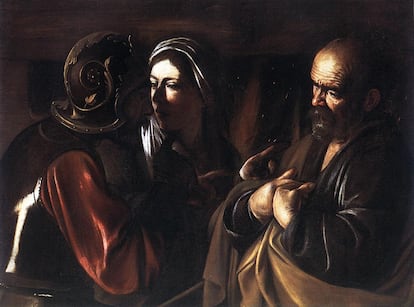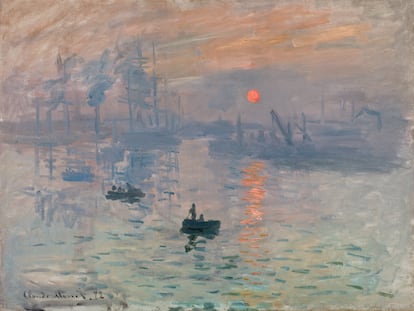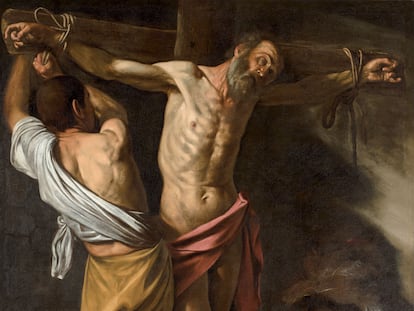Caravaggio’s last painting may not have been his last, after all
London’s National Gallery has ‘The Martyrdom of Saint Ursula’ on exhibition as the Italian genius’ final work, but various experts have cast doubts on the distinction


It is an epiphany of ancient art. “The last Carvaggio.” Or, the “discovery of the lost Caravaggio.” Anything that has to do with the genius from Lombardy guarantees long lines to enter the museum of the old masters. And so, London’s National Gallery will exhibit The Martyrdom of Saint Ursula (its original title was Saint Ursula Struck Down by the Tyrant), which recalls the story of the 11,000 virgins who were led by a chaste maiden on a suicidal pilgrimage across Germany, as recorded in the Golden Legend, a collection of stories about the lives of saints and martyrs.
“And then all these virgins came with the bishops to Cologne, and found that it was besieged with the Huns. And when the Huns saw them, they began to run upon them with a great cry, and araged like wolves on sheep,” tells the anthology, which was written by Jacobus Voragine in the 13th century. Amidst this carnage, the general of the Huns became transfixed by the beauty of Saint Ursula. If she agreed to be his wife, he would spare her life. She refused and he skewered her with an arrow to the stomach, which, in Caravaggio’s painting, the martyr regards with the calm of the inevitable. Three other figures witness the atrocity. The saint’s servant attempts to block the arrow with her hand (a detail that appeared after restoration), a soldier rushes to hold her up in the case that she faints, and between the two of them appears the face of a young man who gazes upon this horror: the painter’s self-portrait. His mouth gapes, perhaps feeling the pain and premonition of his own near death, on a shore plagued with mosquitos. This is the moment captured by Caravaggio on the canvas that is on display in London, lent to the museum by the Intesa Sanpaolo Group. The exhibit’s marketing campaign identifies the piece as Caravaggio’s last, but certain doubts have arisen as to the veracity of that fact.
According to its documentation, the painting was finished on May 11, 1610, two months prior to the artist’s death. “It is possible that he painted other works afterward, like The Denial of Saint Peter [which today, is part of New York’s Metropolitan Museum of Art],” says Giuseppe Porzio, one of the world’s leading experts on the Lombardy painter. This piece, according to art historian Rossella Vodret, “was illegally exported” in 1964 to Switzerland and from there, via the Schickman Gallery, arrived at the New York museum.
The story depicted in The Denial of Saint Peter is told in the New Testament. It speaks of how, as Jesus prophesied in the garden of Gethsemane when he was apprehended, his disciple Peter would deny knowing him three times before the cock crowed twice. The painter moves this action to an interior scene. Only three characters appear. To the left, with his face in the shadows, is one of the henchmen of high priest Caiaphas. His face, amid the gloom, and his hands (poorly defined) are only glimpsed. The cloth of his sleeve is of an indeterminate red.
“At his side, a girl,” writes biographer Andrew Graham-Dixon, “represents the two handmaids who questioned Peter.” Her gaze is fixed on the soldier, her face spotted as if from a disease (or the light of a poorly represented fire), and her rough hand, which points to the apostle, is barely outlined. Peter points to himself, weeping, and acknowledges that he has failed Jesus. But the master avoids painting the scene’s details. He hides its difficult parts in the shadows, elides his characters. Something is not right. Surely, his wounds still gape, his eyesight fails and hands tremble. His physical precision and gift for the placement of light has disappeared.

A mere seven months before, Caravaggio had been assaulted in the Osteria Il Cerriglio, an infamous (it appears in the work of Cervantes) Naples dive that combined drinking (on the first floor) and sex work (on the second) by both genders. The master had wounded a Knight of Malta during his time on the island, and these men of “honor” weren’t given to forgiving or forgetting affronts.
Caravaggio survived a beating and was “punished” with a vendetta called sfregio, which consisted of cutting his face with a razor. A lifelong scar. In that time, barbers were surgeons and literally sewed up wounds. It’s surprising to see his self-portrait in Saint Ursula, beholding the scene in front of him with an untouched, shaven face, horrified by the execution (his own fear that he would not be pardoned by the Pope for having killed the pimp Ranuccio Tomassoni in Rome in 1606?) and even appearing far younger than his 39 years at the time. Was this the look of someone who would die within 60 days? It was impossible that he’d healed. From October 1609 to May 1610, we know nothing of Caravaggio. He most likely hid in the Palazaao Colonna in Chiaia, fighting for his life with 17th century medical treatment.
There is no doubt that Saint Ursula is associated with the artist’s second stay in Naples (1609-1610) and that it was commissioned by Prince Marcantonio Doria, the Prince of Angri and Duke Eboli. “But there are no indications that it was the last work he painted,” says Nicola Spinosa, an Italian Caravaggio expert. For many years, there were doubts about the authorship of the work, with guesses ranging from a young Mattia Preti (1613-1699), to the irregular painter Mesia Alonzo Rodríguez (1578-1648), to Bartolomeo Manfredi (1582-1622). After the discovery of the commission’s documentation and the inscription of the initials M.A.D. on its reverse side, Italian art historian Mina Gregori correctly linked it (in 1975) to Caravaggio. The painting — which today is in a state that could benefit from further restoration — has a unique history. Lanfranco Masa, who worked for the Doria family, put it in the sun to dry. The heat flattened its paint, “because Caravaggio painted very thick layers,” says Masa, and it took the Lombardy painter two weeks to restore the canvas. On May 27, it arrived in Genoa.
But back to the mystery. Two great experts on Caravaggio raise the possibility of Saint Ursula not being the master’s last painting. Biographer Helen Langdon thinks his final work was Saint John the Baptist (1610), a painting done for Cardinal Scipione Borghese, who stepped in to facilitate Caravaggio’s papal pardon. The painter traveled with the canvas in a barge bound for Rome, along with a letter of safe conduct from the Duke of Mantua, Fernando Gonzaga. Nothing could go wrong. But everything went wrong. Wrongfully imprisoned en route, in a Spanish garrison in Porto Ercole, he never reached his destination, possibly due to malaria, septicemia, a heart attack or his unhealed wounds. He succumbed on those shores, a mere 50 miles from Rome. Who can imagine Caravaggio’s desolation, anguish and horror at having come so close to salvation? Such was the end of the master of chiaroscuro.
Sign up for our weekly newsletter to get more English-language news coverage from EL PAÍS USA Edition
Tu suscripción se está usando en otro dispositivo
¿Quieres añadir otro usuario a tu suscripción?
Si continúas leyendo en este dispositivo, no se podrá leer en el otro.
FlechaTu suscripción se está usando en otro dispositivo y solo puedes acceder a EL PAÍS desde un dispositivo a la vez.
Si quieres compartir tu cuenta, cambia tu suscripción a la modalidad Premium, así podrás añadir otro usuario. Cada uno accederá con su propia cuenta de email, lo que os permitirá personalizar vuestra experiencia en EL PAÍS.
¿Tienes una suscripción de empresa? Accede aquí para contratar más cuentas.
En el caso de no saber quién está usando tu cuenta, te recomendamos cambiar tu contraseña aquí.
Si decides continuar compartiendo tu cuenta, este mensaje se mostrará en tu dispositivo y en el de la otra persona que está usando tu cuenta de forma indefinida, afectando a tu experiencia de lectura. Puedes consultar aquí los términos y condiciones de la suscripción digital.
More information
Archived In
Últimas noticias
Most viewed
- Reinhard Genzel, Nobel laureate in physics: ‘One-minute videos will never give you the truth’
- Oona Chaplin: ‘I told James Cameron that I was living in a treehouse and starting a permaculture project with a friend’
- Pablo Escobar’s hippos: A serious environmental problem, 40 years on
- Why we lost the habit of sleeping in two segments and how that changed our sense of time
- Chevy Chase, the beloved comedian who was a monster off camera: ‘Not everyone hated him, just the people who’ve worked with him’










































